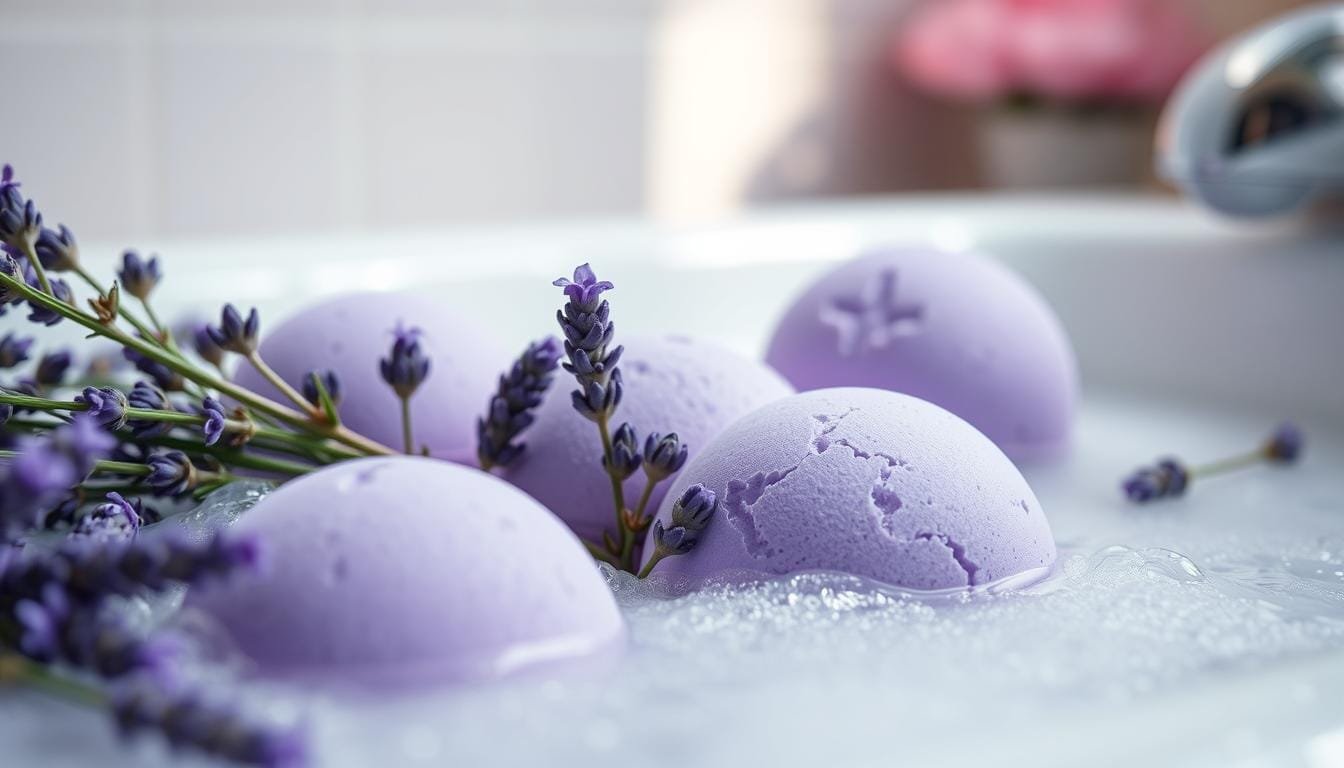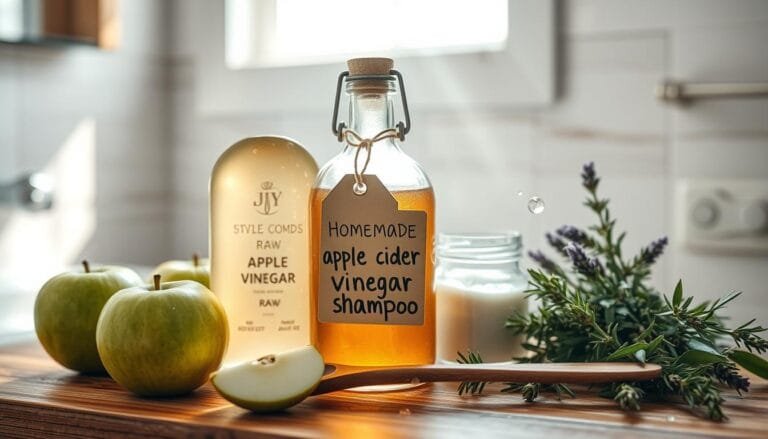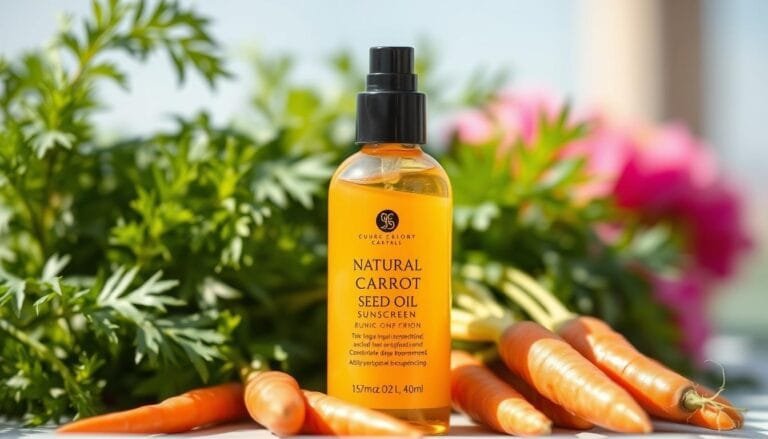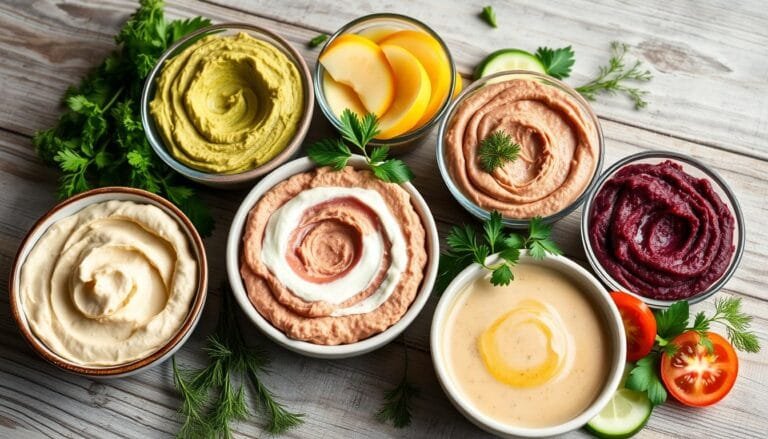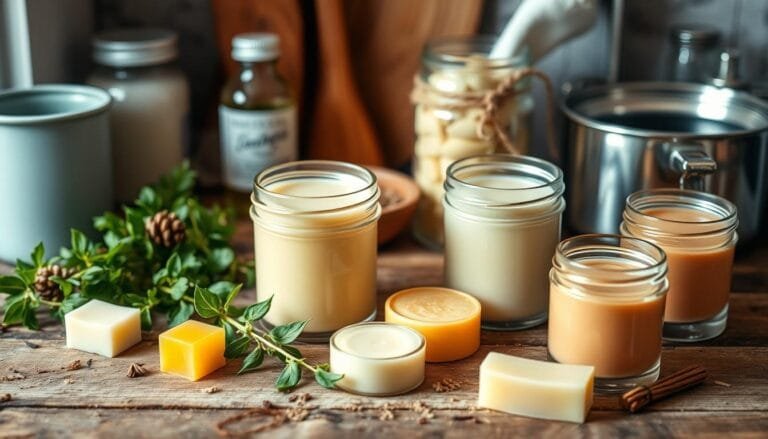I love using lavender bath bombs for self-care at home. They make my spa time truly special. These bath bombs are made with natural stuff like Sodium Bicarbonate and Lavender Essential Oil. They help me relax and feel refreshed.
The Relax & Restore Bath Bomb from Great Lakes Lavender Farm in Rockford, Michigan, is amazing. It’s big, weighing 5 oz (142g). It turns my bath into a peaceful place, making my skin feel good and my senses calm. Buying it helps grow new lavender plants, making it a special self-care act.
I’m all about DIY bath bombs and lavender’s calming effects. These bath bombs are great for unwinding, self-care, or a home spa. They fill the air with a soothing scent, ease my tension, and leave my skin soft and new. It’s amazing how nature can make us feel so good.
The Ultimate Guide to DIY Lavender Bath Bombs
Indulge in the soothing aroma of lavender with these homemade bath bombs. Making your own lavender bath bombs at home lets you pick the ingredients. You get to enjoy the calming benefits of lavender essential oil.
Understanding the Therapeutic Benefits
Lavender bath bombs do more than just make your bath fizzy and luxurious. They have calming and relaxing properties. These can help ease muscle tension, improve sleep, and reduce stress and anxiety. Adding lavender to your bath can make it a truly restorative self-care experience.
Essential Ingredients Overview
- Baking soda
- Citric acid
- Epsom salt
- Dried lavender buds
- Lavender essential oil
- Coconut oil
These ingredients combine to create the fizz and soothing scent of lavender bath bombs.
Basic Equipment Needed
- Mixing bowls
- Large spoon
- Spray bottle
- Silicone molds
With just a few simple tools, you can make your own luxurious lavender bath bombs at home. The lavender bath bomb recipe and step-by-step guide make it easy and fun.
“Crafting homemade lavender bath bombs allows you to create a truly customized self-care experience.”
Natural Ingredients That Make Perfect Bath Bombs
Creating the perfect bath bombs starts with natural ingredients. These ingredients add fizz, soften skin, and offer aromatherapy benefits. Each one is essential for a relaxing bath experience. Let’s look at the best natural ingredients for homemade bath bombs.
The core of a bath bomb is sodium bicarbonate (baking soda) and citric acid. When mixed with water, they create the fizz that bath bombs are known for. Epsom salt adds to the skin’s softness, while coconut oil moisturizes.
Dried lavender buds and lavender essential oil are key for a calming bath. Lavender’s scent relaxes the mind and body. You can also add other oils like bergamot or sandalwood for unique scents.
| Ingredient | Function |
|---|---|
| Sodium Bicarbonate (Baking Soda) | Provides fizzing action |
| Citric Acid | Enhances fizzing and helps create a bubbly bath |
| Epsom Salt | Softens and nourishes the skin |
| Coconut Oil | Adds a luxurious, moisturizing base |
| Lavender Buds | Provides a calming, aromatic experience |
| Lavender Essential Oil | Enhances the relaxing, soothing properties of the bath bombs |
By choosing and mixing these natural ingredients, you can make bath bombs that are beautiful and relaxing. Let nature’s power take you to a place of deep relaxation with your homemade bath bombs.

The Science Behind Bath Bomb Fizzing Action
Ever wondered why bath bombs fizz when you drop them in the tub? It’s all about the chemistry. Baking soda and citric acid, common in bath bombs, are the main actors in this show.
Chemical Reaction Explained
When a bath bomb meets warm water, a chemical reaction starts. This reaction makes carbon dioxide gas, which creates the fizzing bubbles. These bubbles keep forming as the bath bomb dissolves, making your bath even more fun.
Why Citric Acid Matters
Citric acid is key to the fizz. It reacts with baking soda to make carbon dioxide gas. Without it, the bath bomb wouldn’t fizz. The right mix of baking soda and citric acid makes the perfect fizzing bath bomb.
Bath bombs also have extra goodies like essential oils and Epsom salts. These add to the relaxing and hydrating experience. They make your bath aromatic and soothing for both body and mind.
“The fizzing reaction in bath bombs is a captivating display of chemistry in action, transforming your everyday bath into a luxurious self-care ritual.”
So, the next time you enjoy a fizzing bath bomb, think about the science behind it. It’s what makes your bath so special and rejuvenating.
Step-by-Step Recipe for Homemade Lavender Bath Bombs
Making your own lavender bath bombs at home is simple. You just need a few ingredients and some hands-on effort. Follow this DIY bath bomb tutorial to create your own batch of calming lavender bath bombs.
Ingredients Needed
- 2 cups baking soda
- 1 cup citric acid
- 1/2 cup cornstarch
- 30 drops lavender essential oil
- 1 tsp purple soap colorant (optional)
- 2 tsp sweet almond oil
- 3 tbsp Epsom salt
Instructions
- In a large mixing bowl, combine the baking soda, citric acid, and cornstarch. Whisk until well mixed.
- Add the lavender essential oil and sweet almond oil. Mix well with your hands.
- If you want, add the purple soap colorant for a lavender color.
- Slowly add water while kneading the mix. Stop when it holds shape.
- Pack the mix into a silicone mold, like a heart shape, to form your bath bombs.
- Let the bath bombs dry for 24 hours. Then, carefully remove them from the mold.
- Let them air dry for another 24 hours before using or giving them away.
This recipe makes 3 large (2-inch) bath bombs. You can adjust the amounts to make more or smaller ones. Enjoy your homemade lavender bath bomb creations!
| Ingredient | Quantity |
|---|---|
| Baking Soda | 1 cup |
| Citric Acid | 1/2 cup |
| Cornstarch | 1/2 cup |
| Lavender Essential Oil | 30 drops |
| Purple Soap Colorant | 1 tsp |
| Sweet Almond Oil | 2 tsp |
| Epsom Salt | 3 tbsp |
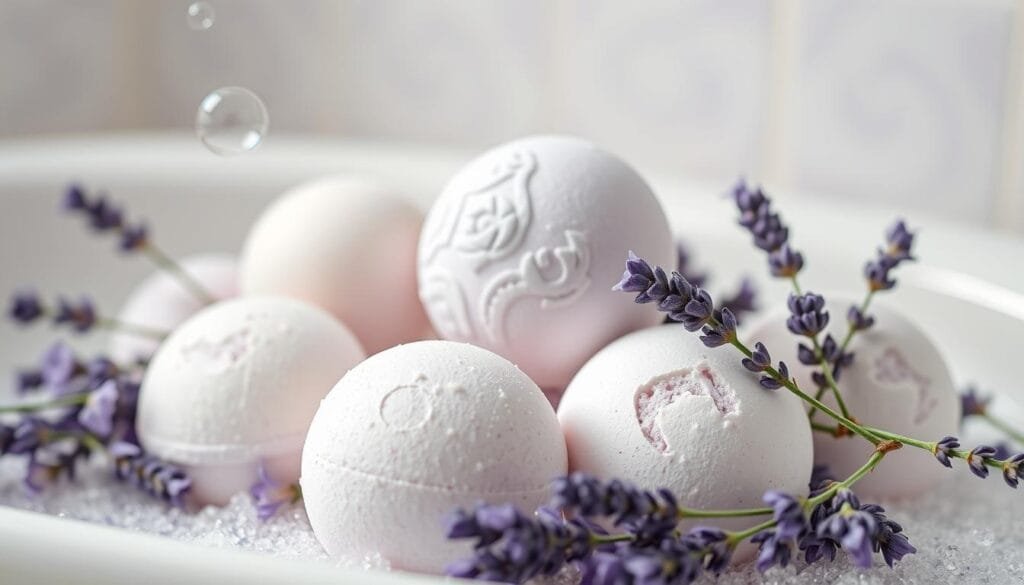
“Making these lavender bath bombs was a wonderfully relaxing experience. The soothing fragrance and fizzy action made for a truly indulgent at-home spa moment.”
Essential Oils and Their Role in Bath Bombs
Essential oils are key in making homemade lavender bath bombs. Lavender oil is a top choice for its calming effects. It helps you relax, sleep better, and feel more peaceful.
Lavender Oil Benefits
Lavender essential oil is made through steam distillation and cold pressing. It’s 100% pure. This oil can improve sleep and reduce insomnia. Its scent is calming, making it great for bath bombs.
Proper Oil Measurements
Using the right amount of essential oils is important. For lavender, about 20 drops are needed for a batch. This amount gives a nice scent without being too strong or irritating.
| Essential Oil Blends | Aromatherapy Bath Bombs |
|---|---|
| Lavender essential oil | Calming and soothing properties |
| Borage oil | Lightweight and skin-loving properties |
| Epsom salt | Contributes to overall product benefits |
“Lavender essential oil has been proven to increase sleepiness and drowsiness, slow heart rate, and lower blood pressure, promoting calming effects helpful for insomnia and restlessness.”
Adding the right amount of lavender essential oil to your bath bombs makes for a peaceful experience. It’s a great way to relax at home.
Creating the Perfect Bath Bomb Shape and Texture
To make bath bombs that feel like a spa, you need the right shape and texture. Start by using silicone ice cube molds or bath bomb molds. These molds help your bath bombs look professional and be the same size.
Your bath bomb mix should be firm but not crumbly. If it’s too dry, add a bit of water or coconut oil. Make sure to pack the mix tightly in the molds for the best shape.
| Ideal Bath Bomb Ingredients | Purpose |
|---|---|
| Baking Soda | Skin softening and detoxifying |
| Citric Acid | Fizzing effect and exfoliation |
| Cornstarch | Texture regulation and dissolution control |
| Epsom Salt | Muscle relaxation and detoxification |
| Coconut Oil | Moisturization and anti-inflammatory properties |
| Witch Hazel | Wetting agent and astringent |
| Lavender Essential Oil | Calming and skin healing properties |
| Dried Lavender Flowers | Decorative touch and fragrance |
By using the right molds and following these tips, you can make bath bombs that feel like a spa. They’ll make your bath time a relaxing, spa-like experience at home.
“The key to crafting the perfect bath bomb is all in the details – from the shape and texture to the carefully selected natural ingredients.”
Tips for Storing Your Handmade Bath Bombs
As a DIY bath bomb lover, I’ve picked up some tips. Keeping your bath bombs fresh and fizzy is all about the right storage. Proper bath bomb storage and preserving bath bombs techniques are essential. This way, your creations will stay good for months.
Humidity Control Methods
Bath bombs hate moisture, so controlling humidity is key. Keep them in a sealed container or wrap each one in plastic. Adding silica gel packets in your containers helps too. They soak up extra moisture and stop fizzing too soon.
Packaging Solutions
The right packaging is vital for preserving bath bombs. Choose strong, dark containers to protect them from UV light. Glass jars or tin canisters are perfect. Stay away from clear plastic, as it lets light in and can harm your bath bombs.
It’s also important to label your bath bombs well. This is true if you’ve made different scents. It helps you keep track of which ones are oldest and use them first.
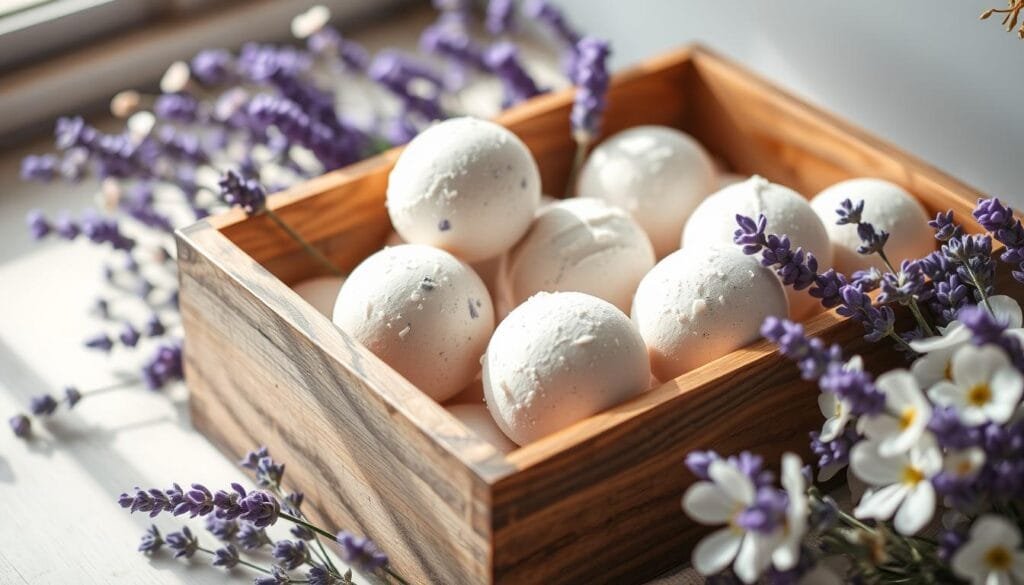
The shelf life of bath bombs varies from six months to a year. By following these storage tips, you can make your bath bombs last longer. Enjoy their relaxing effects for more time.
How to Use Bath Bombs for Maximum Relaxation
Bath bombs are essential for a luxurious spa experience at home. They turn a simple bath into a calming ritual that benefits your body and mind. To enjoy your bath bomb usage fully, follow these easy steps for relaxation techniques. They will make you feel refreshed and renewed.
- Begin by filling your bathtub with warm water. Make sure it’s full before adding your bath bomb.
- Drop the bath bomb into the water and watch it fizz. It will release its scent and beneficial ingredients.
- Use this time to relax and be mindful. Turn off your phone, light candles, and enjoy the bath. You might want to meditate or read a book.
- Soak for 15-20 minutes. This lets your skin absorb the bath bomb’s oils and moisturizers.
- After soaking, rinse off any leftover residue. Then, dry your skin gently with a soft towel.
By following these steps, your bath becomes a luxurious and restorative experience. So, treat yourself to a lavender bath bomb and let your worries fade away.
“Lovely Product – Quickly effervesce and did not leave a chalky residue behind.” – Denise M. Verified Buyer
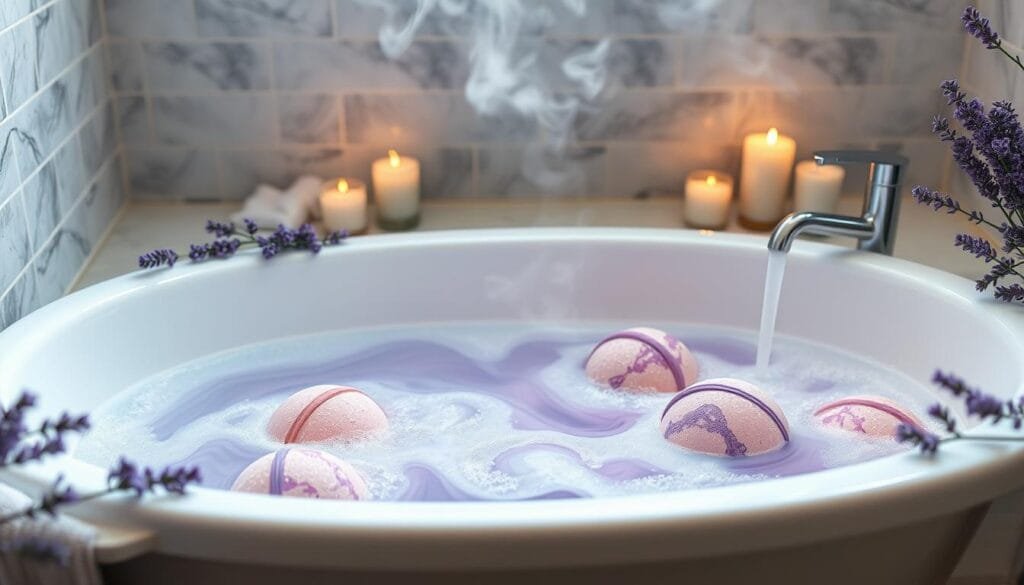
| Product | Retail Value |
|---|---|
| Lavender Bath Bombs | $70 |
| Mini Spa collection | $44 |
| Quiet Night Rituals collection | $113 |
Benefits of Regular Bath Bomb Self-Care Rituals
Adding lavender bath bombs to your self-care routine can greatly benefit your body and mind. These bath bombs are not just a luxury; they offer a healing experience. They can boost your health and happiness.
Physical Benefits
Lavender bath bombs contain coconut oil and Epsom salt, which are great for your skin. They make your skin soft and refreshed. The bath’s warm water and fizz also ease muscle pain, helping you relax and improving blood flow.
Mental Wellness Aspects
Using lavender bath bombs regularly can greatly improve your mental health. The calming scent of lavender reduces stress and anxiety. It also helps you relax and sleep better. This self-care ritual brings you a sense of calm and peace, boosting your mood and emotional health.
| Benefit | Description |
|---|---|
| Skin Softening | Ingredients like coconut oil and Epsom salt in bath bombs can leave your skin feeling soft and rejuvenated. |
| Muscle Relaxation | The warm water and fizzing action of bath bombs can help soothe muscle tension and pain. |
| Stress Reduction | The calming scent of lavender in bath bombs can help reduce stress and anxiety, promoting relaxation. |
| Improved Sleep | Incorporating a lavender bath bomb ritual can enhance sleep quality by inducing a sense of calm and tranquility. |
By adding lavender bath bombs to your self-care routine, you’ll see many benefits. Your skin will improve, muscle tension will decrease, and your mental health will get a boost. This holistic approach to self-care can greatly improve your overall health and life quality.
Troubleshooting Common Bath Bomb Making Issues
Making bath bombs at home can be fun, but sometimes problems arise. Don’t worry, I’m here to help. I’ll share tips on common issues and how to solve them. This way, you can enjoy making bath bombs even more.
One common issue is bath bombs that crumble or are too soft. This usually means they didn’t have enough moisture. To fix this, add more liquid bit by bit until they feel like damp sand. On the other hand, if your bath bombs are too soft and keep an indentation, they might have too much oil or butter.
Cracks in bath bombs often mean they dried too fast. To stop this, try changing the drying area. You can reduce airflow or add more humidity. If your bath bombs are bumpy, they likely had too much moisture.
Another problem is when bath bombs have flat bottoms. This happens if you take them out of the molds too soon. To avoid this, wait until they are completely dry before removing them.
| Issue | Possible Cause | Solution |
|---|---|---|
| Crumbly, soft bath bombs | Insufficient moisture | Gradually add more liquid ingredients |
| Soft bath bombs | Too much oil or butter | Adjust the recipe to reduce oil or butter |
| Cracks in finished bath bombs | Rapid drying | Adjust drying environment (reduce airflow, increase humidity) |
| Bumpy or “warty” bath bombs | Excessive moisture | Reduce the amount of liquid in the mixture |
| Flat bottoms | Removing from molds too early | Allow bath bombs to fully dry before removing from molds |
Remember, making bath bombs is all about trying new things and learning from mistakes. Don’t get discouraged by failures. Each one is a chance to get better and make even more wonderful bath bombs for your self-care.
“With a little trial and error, you’ll be crafting spa-worthy bath bombs in no time!”
Enhancing Your Bath Bombs with Natural Colorants
I love making my own spa at home, and natural colorants have changed the game. I’ve moved away from artificial dyes to organic organic colorants. These not only make my bath bombs look amazing but also care for my skin.
Mica powder is a top pick for me. It’s made from minerals and comes in many colors. It makes my bath bombs shimmer and turn the water into a spa-like treat.
Dried flower petals are another favorite. Lavender, rose, and chamomile add color and calmness. They make the bath feel peaceful and luxurious.
- Mica powder for shimmering hues
- Dried flower petals for natural colors and aromatherapy
- Food-grade coloring for vibrant, skin-safe tints
Playing with these organic colorants lets me make bath bombs that are truly mine. I can make anything from a calming lavender soak to a citrusy fizz. These eco-friendly colors make my self-care routine even better.
Creating a Spa-Like Experience with Lavender Bath Bombs
Escape the stresses of everyday life and turn your bathroom into a luxurious spa. Dim the lights, light some candles, and play calming music. This sets the perfect ambiance for a pampering session at home.
The lavender-infused fizz and aromatherapeutic benefits of these bath bombs will relax you. Slip into the warm, aromatic water and let the lavender essential oils and Epsom salts soothe you. This simple ritual is an affordable way to enjoy a spa-like experience at home.
By using natural ingredients like cornstarch, baking soda, and coconut oil, you can make a lavish bath. Immerse yourself in this rejuvenating self-care routine. You’ll emerge feeling refreshed, renewed, and ready to take on the world.
